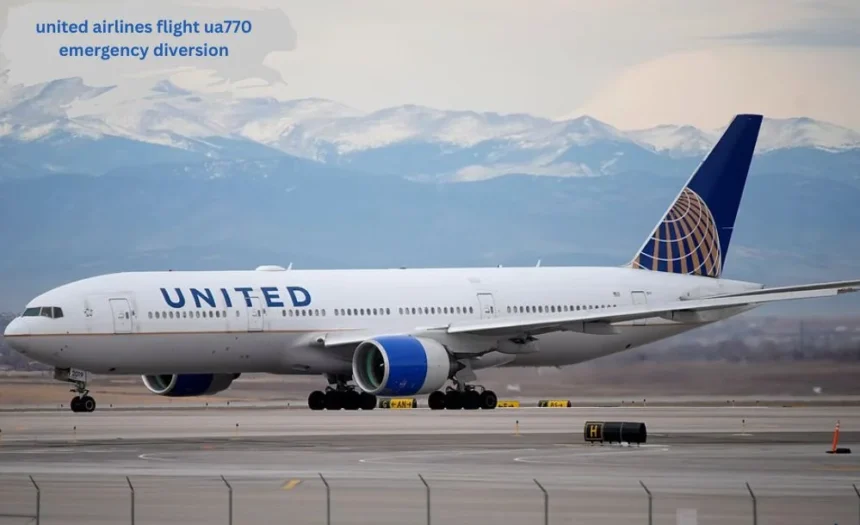The aviation world often united airlines flight ua770 emergency diversion witnesses unexpected moments that test the readiness and resilience of crew, passengers, and airline management. One such incident recently brought attention to United Airlines Flight UA770 emergency diversion, a situation that sparked concern and curiosity among travelers and aviation enthusiasts alike. The event not only highlighted the complexity of air travel but also offered a moment of reflection on safety protocols, human compassion, and airline responsibility. In this article, we will delve into the events surrounding the emergency diversion, its aftermath, and what it means for passengers and the airline industry at large.
The Flight That Started Normally
United airlines flight ua770 emergency diversion was a routine domestic flight that, on the day of the incident, carried dozens of passengers with varied destinations, plans, and expectations. Scheduled to operate from a major U.S. city, the flight was expected to be a smooth journey like countless others. The aircraft, operated by United Airlines a legacy carrier with a long-standing reputation for safety and service was prepared for departure with no major concerns raised during the pre-flight checks.
Passengers boarded as usual, the crew delivered safety instructions, and the aircraft taxied onto the runway. Shortly after takeoff, things seemed to be proceeding normally. However, the story took a different turn not long into the flight, when unexpected circumstances prompted the United Airlines Flight UA770 emergency diversion, catching everyone on board by surprise.
What Prompted the Emergency Diversion?
While official sources typically withhold immediate details to allow for accurate investigations, early reports suggested that the United Airlines Flight UA770 emergency diversion was triggered by a medical emergency involving a passenger. Medical diversions are among the most common reasons for unscheduled landings and are always taken seriously, as every minute can be crucial in life-threatening situations.
The flight crew was reportedly alerted by fellow passengers or the affected individual themselves, and promptly followed airline protocols. Pilots communicated with air traffic control to declare an emergency and request clearance for the nearest appropriate airport. Flight data trackers later confirmed a sharp deviation from the original route, and within minutes, the aircraft was en route to a new destination that could accommodate immediate medical assistance. The rapid response reflected not only the professionalism of the crew but also the importance United Airlines places on passenger welfare, regardless of inconvenience or cost.
The Diversion and Safe Landing
After rerouting, the aircraft began a controlled descent towards the designated airport. Crew members onboard managed the cabin with calm reassurance, keeping passengers informed while attending to the individual in distress. The entire cabin was united in concern, demonstrating how shared humanity can emerge even at 30,000 feet. Upon landing, emergency medical personnel were already on standby. The passenger was promptly transferred to awaiting medical services. The United Airlines Flight UA770 emergency diversion thus concluded with what aviation experts would describe as a textbook emergency response safe, timely, and executed with professionalism.
Following the emergency, the airline worked swiftly to manage the continuation of the flight. Passengers were either reboarded after a short delay or offered alternative options to reach their final destinations. United Airlines, in a public statement, thanked the flight crew, airport staff, and passengers for their cooperation and understanding.
Impact on Passengers and Operations
Though the diversion caused an unexpected delay, passengers generally expressed gratitude rather than frustration. Most understood that the United Airlines Flight UA770 emergency diversion was necessary and ultimately life-saving. Some passengers even shared their experiences on social media, praising the crew’s poise under pressure and the airline’s clear communication. From an operational standpoint, such diversions can cause ripple effects across airline schedules. Aircraft availability, crew duty limits, and passenger rebooking efforts must be recalibrated. However, United airlines flight ua770 emergency diversion demonstrated flexibility and commitment to minimizing the disruption. Passengers affected by the delay received updates, refreshments, and in some cases, compensation or travel vouchers.
Despite the logistical challenges, the airline’s focus remained firmly on ensuring passenger safety and satisfaction, a reflection of its broader commitment to responsible air travel.
A Broader Look at Airline Emergency Protocols
The United Airlines Flight UA770 emergency diversion also underscores the importance of established emergency response procedures within commercial aviation. Airlines around the world, especially those with global reach like United, invest significant resources in training flight crews to handle a range of emergencies from medical incidents and mechanical issues to security threats. Cabin crew members undergo rigorous first aid and emergency response training. Pilots are trained to communicate effectively with air traffic control and make fast decisions in the air. Additionally, aircraft are equipped with essential medical kits and automated external defibrillators (AEDs), which can prove critical during such events.
The Human Side of an In-Flight Emergency
What often gets lost in technical analyses of flight diversions is the emotional impact such events can have on passengers. The United Airlines Flight UA770 emergency diversion wasn’t just a disruption; it was a moment of shared vulnerability. Passengers likely experienced anxiety, confusion, or even fear, especially without immediate details about what was happening.
However, such incidents often bring out unexpected acts of kindness. Onboard accounts revealed passengers offering words of support to the affected person, comforting fellow travelers, or simply being patient and understanding amid the uncertainty. The incident became a subtle reminder of the collective human experience how strangers, momentarily connected by a flight number, come together when it matters most.
Public Reaction and Media Coverage
As news of the United Airlines Flight UA770 emergency diversion circulated, media outlets picked up the story, offering brief updates and expert commentary. Social media, too, became a platform for firsthand passenger accounts. Some travelers posted praise for the airline, while others simply reflected on the emotional weight of witnessing a real emergency unfold in the skies. Unlike more dramatic aviation stories, this incident didn’t result in chaos or controversy. Instead, it became an example of how well-functioning systems and empathetic humans can manage a high-stress situation. In an era where airlines are often scrutinized for missteps, United Airlines received rare applause for its handling of the event.
Moving Forward: Lessons for Airlines and Passengers
The aviation industry continuously evolves, learning from every incident, no matter how small. The United Airlines Flight UA770 emergency diversion will likely be reviewed internally not to assign blame, but to improve systems even further. For passengers, the incident is a reminder to always take pre-flight safety briefings seriously, stay aware during flights, and carry essential medical information if needed. For airlines, it’s a prompt to continue investing in crew training, communication systems, and passenger care. At a broader level, the incident reaffirms the importance of maintaining trust between airlines and their customers. Emergencies may be rare, but how they are handled speaks volumes about a company’s integrity and readiness.
Conclusion
The United Airlines Flight UA770 emergency diversion serves as a poignant case study in modern aviation a moment where professionalism, preparedness, and compassion came together in the skies. While emergencies are never desirable, how they’re handled can make all the difference. United Airlines, through the quick actions of its crew and support staff, demonstrated not only compliance with aviation safety standards but also a deep sense of human care. In a world where news travels fast and opinions form faster, it’s refreshing to see a story where an airline rises to the occasion. For the passengers on board, the diversion was more than a delay it was a moment of shared humanity, a testament to the importance of staying calm, supportive, and informed. As the aviation community reflects on this event, it offers reassurance that even in the clouds, care and safety remain the top priorities.



